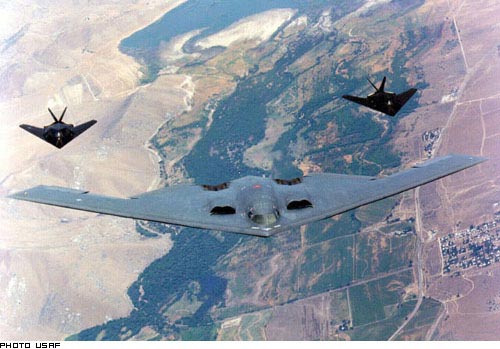Northrop B-2 Spirit
Summary
| Category | Bomber |
| Origin country | 🇺🇸 United States |
| First flight | 17 July 1989 |
| Year of introduction | 1993 |
| Number produced | 21 units |
| Average unit price | $750 million |
Description
Development began under the Advanced Technology Bomber (ATB) project in 1979, during the Carter administration, following the cancellation of the B-1A bomber. Northrop (later Northrop Grumman) was selected as the prime contractor, with Boeing, Hughes, and Vought as principal subcontractors. The Northrop team's ATB design, code named "Senior Ice", was chosen over the Lockheed/Rockwell design on 20 October 1981, receiving the designation B-2 and the name "Spirit". The bomber's design was subsequently modified in the mid-1980s when the mission profile shifted from high-altitude to low-altitude, terrain-following operations. Production continued from 1987 to 2000, with the program ultimately producing 21 B-2s. The B-2 was first publicly displayed on 22 November 1988 at United States Air Force Plant 42 in Palmdale, California, and its first public flight was on 17 July 1989 from Palmdale to Edwards Air Force Base.
The B-2 Spirit was developed with a flying wing design, omitting a traditional fuselage and tail structure. This design integrates low-observable technologies with aerodynamic efficiency and a large payload capacity. The aircraft's stealth characteristics are achieved through a combination of reduced acoustic, infrared, visual, and radar signatures, designed to evade detection systems. Its design and construction required the use of pioneering computer-aided design and manufacturing technologies to meet stringent requirements for low visibility to detection methods. The B-2 shares a resemblance to earlier Northrop flying wing aircraft such as the YB-35 and YB-49, with similarities in wingspan. The aircraft's inherent stealth capabilities reduce the necessity for supporting aircraft typically used to provide air cover, suppression of enemy air defenses, and electronic countermeasures.
The B-2 Spirit is equipped with two internal bays capable of carrying up to 40,000 lb (18,000 kg) of ordnance. Munitions can be stored on a rotary launcher or on bomb-racks. The aircraft is capable of deploying both conventional and nuclear weapons. Nuclear ordnance includes the B61 and B83 nuclear bombs. For conventional warfare, the B-2’s arsenal includes Mark 82 and Mark 84 bombs, CBU-87 Combined Effects Munitions, GATOR mines, and the CBU-97 Sensor Fuzed Weapon. The aircraft can carry up to eighty 500 lb (230 kg) class bombs, such as Mk-82s or GBU-38s, mounted on Bomb Rack Assemblies (BRAs). An upgrade program increased the maximum carriage capacity to 80 Joint Direct Attack Munitions (JDAMs). The B-2 is compatible with the Massive Ordnance Penetrator (MOP), a 30,000 lb (14,000 kg) bomb designed for attacking reinforced bunkers, capable of carrying up to two MOPs, one in each bay. The AGM-158 Joint Air-to-Surface Standoff Missile (JASSM) is a standoff munition deployed on the B-2, and the aircraft is slated to eventually carry the Long Range Standoff Weapon.
The B-2's operational history began in 1999 during the Kosovo War, where it was employed in non-stop flights from Missouri to Yugoslavia and back, lasting 30 hours. The aircraft saw action in Afghanistan in 2001, with missions extending from Missouri, supported by aerial refueling. By 2003, B-2s were stationed in the Middle East amidst a U.S. military buildup, and the aircraft was deployed during the Iraq War, operating from Diego Garcia and forward locations. Noted shortcomings in serviceability during this period related to the maintainability of the low observable coatings and issues with the Defensive Avionics suite. The B-2 was utilized in Operation Odyssey Dawn in 2011, flying directly from the U.S. to strike targets in Libya. In 2017, two B-2s struck an ISIS training camp in Libya. In October 2024, B-2As were used in strikes against Houthi weapon storage facilities in Yemen, staging from RAAF Base Tindal in Australia. The United States Air Force is the sole operator of the B-2 Spirit.
Main Variants:
-
Prototype: A test model converted to Block 30 fully operational status.
-
Block 10: Initial production configuration with limited combat capabilities, primarily for training.
-
Block 20: Interim configuration adding some combat capabilities, including GPS-aided targeting.
-
Block 30: The final, fully operational configuration with enhanced combat capabilities, including the ability to deploy a wider range of munitions.
Technical specifications
| Version: B-2 Spirit | |
|---|---|
| Crew | 2 pilots |
| Operational range | 12000 km (7456 mi) |
| Maximum speed | 972 km/h (604 mph) |
| Wing area | 478 m² (5145.1 sqft) |
| Wingspan | 52 m (170.6 ft) |
| Height | 5 m (16.4 ft) |
| Length | 21 m (68.9 ft) |
| Service ceiling | 15240 m (50000 ft) |
| Empty weight | 71668 kg (158001 lbs) |
| Max. takeoff weight | 170200 kg (375226 lbs) |
| Powerplant | 4 × turbojets General Electric F118-GE-100 delivering 7847 kgp |
| Ejection seat | McDonnell Douglas ACES II |
Current operating countries
| Country | Units | ||
|---|---|---|---|
|
|
United States | 18 | |
Numbers in parentheses, e.g. '(+5)', indicate units ordered but not yet delivered.
All operators
Armament
Bombs payload:
- Thermonuclear B61
- Guided Boeing GBU-57A/B
- Thermonuclear Livermore B83
- Low-Drag Mk 82
- Low-Drag Mk 84
Photo of B-2 Spirit

3-view profile
